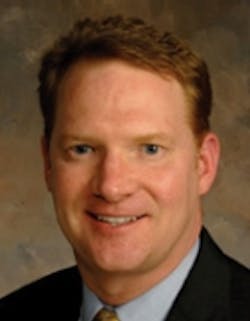Dr. Joe Blaes interviews Steve Boggan BioHorizons
1. I understand that you were trained as a biomedical engineer. What insight does this training give you to the development of products in the implant market?
Having an MS in biomedical engineering is a significant advantage in terms of identifying product trends and opportunities in the industry. Recognizing the need for adjunctive hard- and soft-tissue grafting, we were the first implant company to offer a broad range of biologics products for tissue regeneration. We also brought a number of innovations to implant dentistry including resorbable, blast-textured implant surfaces, implant threads that load bone in compression, drills with integrated stops, and an implant mount that serves as an impression coping and esthetic abutment. That said, our most significant advancement was recognizing the potential benefits of laser microchannels to address the most common complications of implant dentistry — bone loss and soft tissue recession.
2. That is an important point. What are laser microchannels and why is this important?
Laser-Lok is a series of repeating laser microchannels of 8 to 12 microns in width and depth that are produced with an excimer laser under tightly controlled conditions. In-vitro, animal, and human clinical research demonstrated the ability of Laser-Lok to retard epithelial downgrowth, attract a physical connective tissue attachment, and attach and retain crestal bone. A team of researchers at a hospital in New York invented this technology for joint diseases. Their research focus was to control cell growth and differentiation on implant surfaces. There are now more than 20 peer-reviewed articles demonstrating the benefits of the Laser-Lok surface on implants and abutments.
3. The cost of implants is an important factor for patients deciding between implants, crown and bridgework, or traditional dentures. What is your view on the cost of implants?
You bring up an excellent point. Cost is a critical issue for patients, especially in the current economy. In fact, the United States has one of the lowest penetration rates for implants in the world. It is estimated that less than 10% of patients being treated for tooth loss receive an implant-supported restoration. I believe that increased training for private practice dentists and current dental students will create a substantial adoption of implants over the next five to 10 years.
Our implants are typically priced 10% to 20% less than the competition. In addition, all of our standard diameter bone level implants are provided with an esthetic abutment implant mount. This mount serves as a surgical implant mount, an impression coping, and a final abutment. These components typically cost $150 to $200 from other manufacturers, so the cost savings for the dentist can be significant.
4. Peri-implantitis seems to be the one issue that haunts every implant manufacturer. How does your implant line deal with this?
The connective tissue attachment generated on the Laser-Lok surface should reduce or prevent peri-implantitis. The highest burden of proof in medicine is histology. Laser-Lok demonstrated connective tissue attachment in numerous animal and human clinical trials on a histological level. In conjunction with several leading universities throughout the world, we hope to demonstrate the potential of Laser-Lok to prevent peri-implantitis, even in the presence of bacteria and contamination. We believe the application of Laser-Lok to prosthetic abutments may prove to be the most exciting new development in implant dentistry in the last 10 years.
5. Continuing education in the implant field has shifted from having opinion leaders speak, to implant companies having their own teaching facilities. Would you comment on this trend, and how BioHorizons addresses it?
Our philosophy has been, and will continue to be, to partner with leading private and public educational institutions for training in tissue regeneration and implant dentistry. I believe an independent training curriculum is more beneficial for the dentist than a company course. We are fortunate to be affiliated with the leading private and university-based teaching facilities around the world.
6. More implants are being designed for the general practitioner, particularly mini-implants. How does your product line address the general dentist?
We were the first company to offer a narrow 3.0 mm implant that was cleared by the FDA for permanent use. Mini-implants smaller than 3.0 mm in diameter are successful, albeit at a reduced success rate. Since our mission is to provide the most predictable treatment outcomes, we recommend a 3.0 mm or higher diameter implant. From a cost and functional comparison, two standard implants with an overdenture attachment are approximately the same cost as four mini-implants, and with better predictability.
7. Dr. Sonia Leziy is a key opinion leader in the field. It seems like there are very few women dentists who have reached that status with implants. We know that women account for 50% of the current dental school graduates. What plans does your company have for Dr. Leziy and the marketplace of women dentists?
We are extremely impressed with Dr. Leziy’s clinical skills, understanding of dental implant design, and superb quality of her presentations. We are pleased to be working with her because of these attributes. Dr. Leziy is in a unique position to teach and lead female dentists.
Steve Boggan is a 1986 graduate of Mississippi State University with a BS in biological engineering, and an MS in biomedical engineering from the University of Alabama at Birmingham in 1989. He received an MBA from the University of Memphis in 1995. Boggan joined BioHorizons in 1995, and was promoted to president and CEO in 1999. He was named one the most influential medical device executives by Medical Device & Diagnostic Industry magazine.
Past DE Issues
